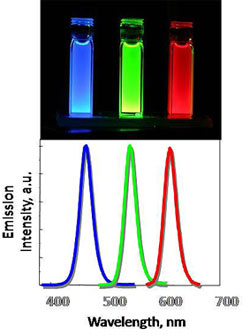Quantum dots go on display
January 17, 2013

(Credit: QD Vision)
Researchers working with nanoscale fluorescent particles called quantum dots have long predicted groundbreaking achievements, such as ultra-efficient light-emitting diodes (LEDs) and solar cells, but the technology has found mainly niche applications.
That could change with the announcement last week that QD Vision would supply Sony Corporation of Tokyo with quantum dots for flat-screen televisions that will transmit more richly colored images than other TVs on the market, Nature News reports.
Quantum dots are crystals about 10 nanometers in diameter, made from a semiconductor material, commonly cadmium selenide. They are so tiny that their shape and size affect the quantum properties of their electrons, in particular their energy gap — the energy needed to kick electrons into a higher-energy band — which determines the color of light that the material can emit.
Whereas a bulk semiconductor is limited to emitting a single color of light, researchers can tune the precise color a quantum dot will absorb and re-emit by tailoring its size.